Critical Literature Review: Child Protection Issues and Skills
VerifiedAdded on 2022/08/27
|12
|2653
|19
Report
AI Summary
This report provides a critical literature review on child protection, addressing the theoretical knowledge and skills of healthcare professionals, social workers, and community members. The paper explores the impact of these factors on child protection policy and practice. It highlights the vulnerability of children and the importance of safeguarding them from harm, violence, and abuse. The report examines the role of healthcare workers in identifying and reporting child abuse cases, the skills required by social workers to effectively engage with children and families, and the influence of community development on child protection. The analysis draws upon various research studies, policies, and initiatives, offering insights into the challenges and opportunities in protecting children. The report also discusses the lack of theoretical knowledge and skills among healthcare, community, and social workers and its impact on child protection. The report concludes with a summary of the key findings and recommendations for improving child protection practices.

Children protection
3 / 3 1 / 2 0 2 0
3 / 3 1 / 2 0 2 0
Paraphrase This Document
Need a fresh take? Get an instant paraphrase of this document with our AI Paraphraser
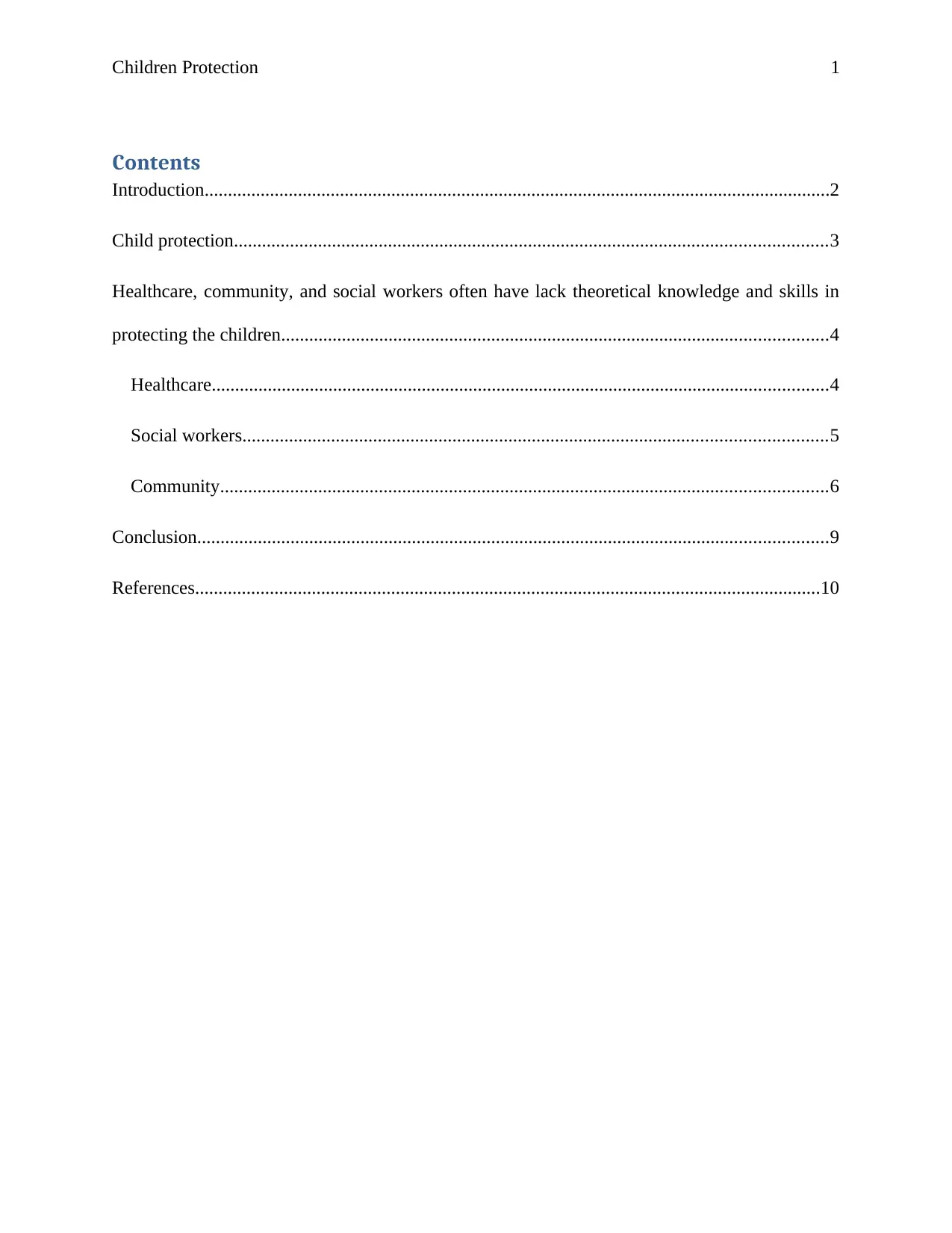
Children Protection 1
Contents
Introduction......................................................................................................................................2
Child protection...............................................................................................................................3
Healthcare, community, and social workers often have lack theoretical knowledge and skills in
protecting the children.....................................................................................................................4
Healthcare....................................................................................................................................4
Social workers.............................................................................................................................5
Community..................................................................................................................................6
Conclusion.......................................................................................................................................9
References......................................................................................................................................10
Contents
Introduction......................................................................................................................................2
Child protection...............................................................................................................................3
Healthcare, community, and social workers often have lack theoretical knowledge and skills in
protecting the children.....................................................................................................................4
Healthcare....................................................................................................................................4
Social workers.............................................................................................................................5
Community..................................................................................................................................6
Conclusion.......................................................................................................................................9
References......................................................................................................................................10
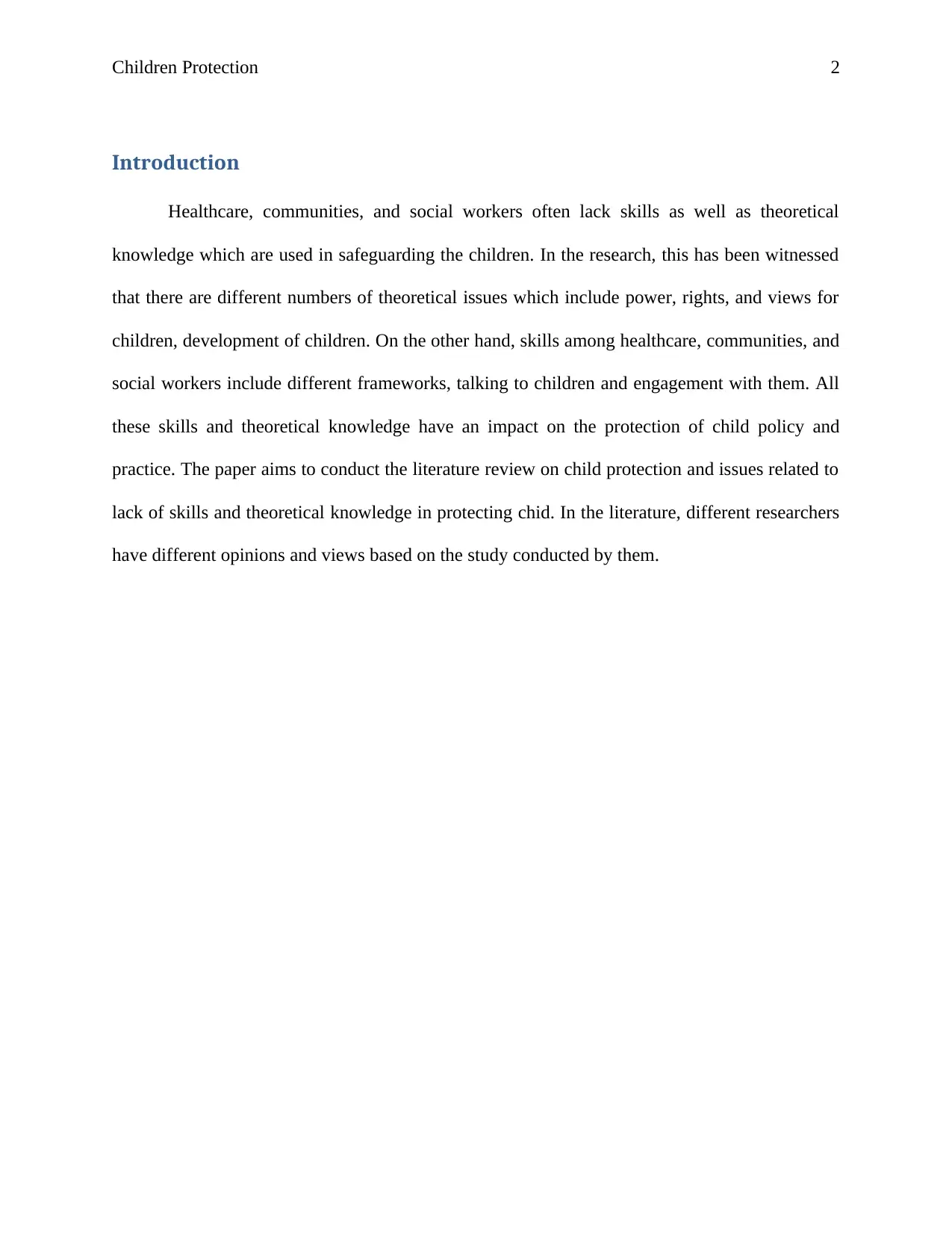
Children Protection 2
Introduction
Healthcare, communities, and social workers often lack skills as well as theoretical
knowledge which are used in safeguarding the children. In the research, this has been witnessed
that there are different numbers of theoretical issues which include power, rights, and views for
children, development of children. On the other hand, skills among healthcare, communities, and
social workers include different frameworks, talking to children and engagement with them. All
these skills and theoretical knowledge have an impact on the protection of child policy and
practice. The paper aims to conduct the literature review on child protection and issues related to
lack of skills and theoretical knowledge in protecting chid. In the literature, different researchers
have different opinions and views based on the study conducted by them.
Introduction
Healthcare, communities, and social workers often lack skills as well as theoretical
knowledge which are used in safeguarding the children. In the research, this has been witnessed
that there are different numbers of theoretical issues which include power, rights, and views for
children, development of children. On the other hand, skills among healthcare, communities, and
social workers include different frameworks, talking to children and engagement with them. All
these skills and theoretical knowledge have an impact on the protection of child policy and
practice. The paper aims to conduct the literature review on child protection and issues related to
lack of skills and theoretical knowledge in protecting chid. In the literature, different researchers
have different opinions and views based on the study conducted by them.
⊘ This is a preview!⊘
Do you want full access?
Subscribe today to unlock all pages.

Trusted by 1+ million students worldwide
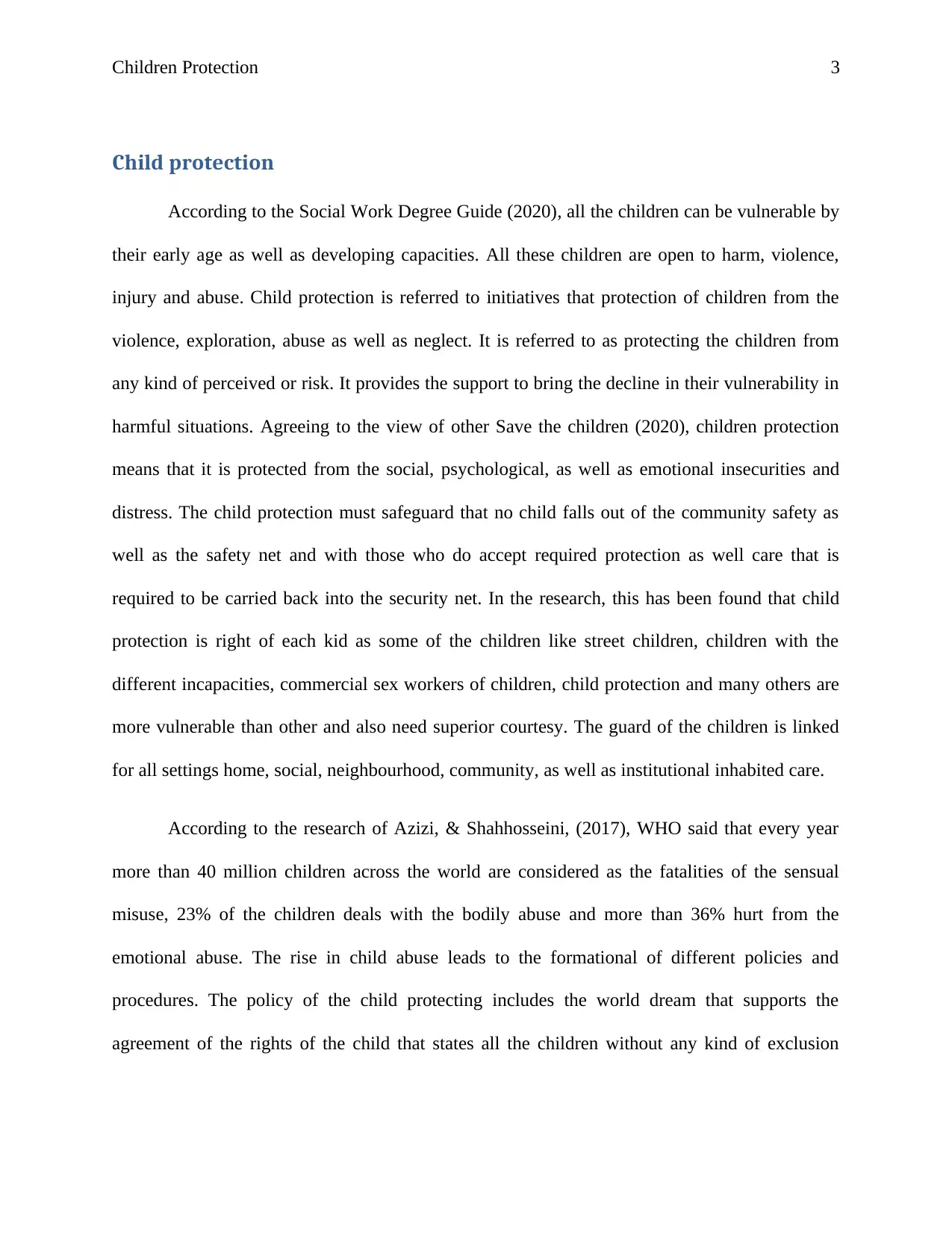
Children Protection 3
Child protection
According to the Social Work Degree Guide (2020), all the children can be vulnerable by
their early age as well as developing capacities. All these children are open to harm, violence,
injury and abuse. Child protection is referred to initiatives that protection of children from the
violence, exploration, abuse as well as neglect. It is referred to as protecting the children from
any kind of perceived or risk. It provides the support to bring the decline in their vulnerability in
harmful situations. Agreeing to the view of other Save the children (2020), children protection
means that it is protected from the social, psychological, as well as emotional insecurities and
distress. The child protection must safeguard that no child falls out of the community safety as
well as the safety net and with those who do accept required protection as well care that is
required to be carried back into the security net. In the research, this has been found that child
protection is right of each kid as some of the children like street children, children with the
different incapacities, commercial sex workers of children, child protection and many others are
more vulnerable than other and also need superior courtesy. The guard of the children is linked
for all settings home, social, neighbourhood, community, as well as institutional inhabited care.
According to the research of Azizi, & Shahhosseini, (2017), WHO said that every year
more than 40 million children across the world are considered as the fatalities of the sensual
misuse, 23% of the children deals with the bodily abuse and more than 36% hurt from the
emotional abuse. The rise in child abuse leads to the formational of different policies and
procedures. The policy of the child protecting includes the world dream that supports the
agreement of the rights of the child that states all the children without any kind of exclusion
Child protection
According to the Social Work Degree Guide (2020), all the children can be vulnerable by
their early age as well as developing capacities. All these children are open to harm, violence,
injury and abuse. Child protection is referred to initiatives that protection of children from the
violence, exploration, abuse as well as neglect. It is referred to as protecting the children from
any kind of perceived or risk. It provides the support to bring the decline in their vulnerability in
harmful situations. Agreeing to the view of other Save the children (2020), children protection
means that it is protected from the social, psychological, as well as emotional insecurities and
distress. The child protection must safeguard that no child falls out of the community safety as
well as the safety net and with those who do accept required protection as well care that is
required to be carried back into the security net. In the research, this has been found that child
protection is right of each kid as some of the children like street children, children with the
different incapacities, commercial sex workers of children, child protection and many others are
more vulnerable than other and also need superior courtesy. The guard of the children is linked
for all settings home, social, neighbourhood, community, as well as institutional inhabited care.
According to the research of Azizi, & Shahhosseini, (2017), WHO said that every year
more than 40 million children across the world are considered as the fatalities of the sensual
misuse, 23% of the children deals with the bodily abuse and more than 36% hurt from the
emotional abuse. The rise in child abuse leads to the formational of different policies and
procedures. The policy of the child protecting includes the world dream that supports the
agreement of the rights of the child that states all the children without any kind of exclusion
Paraphrase This Document
Need a fresh take? Get an instant paraphrase of this document with our AI Paraphraser
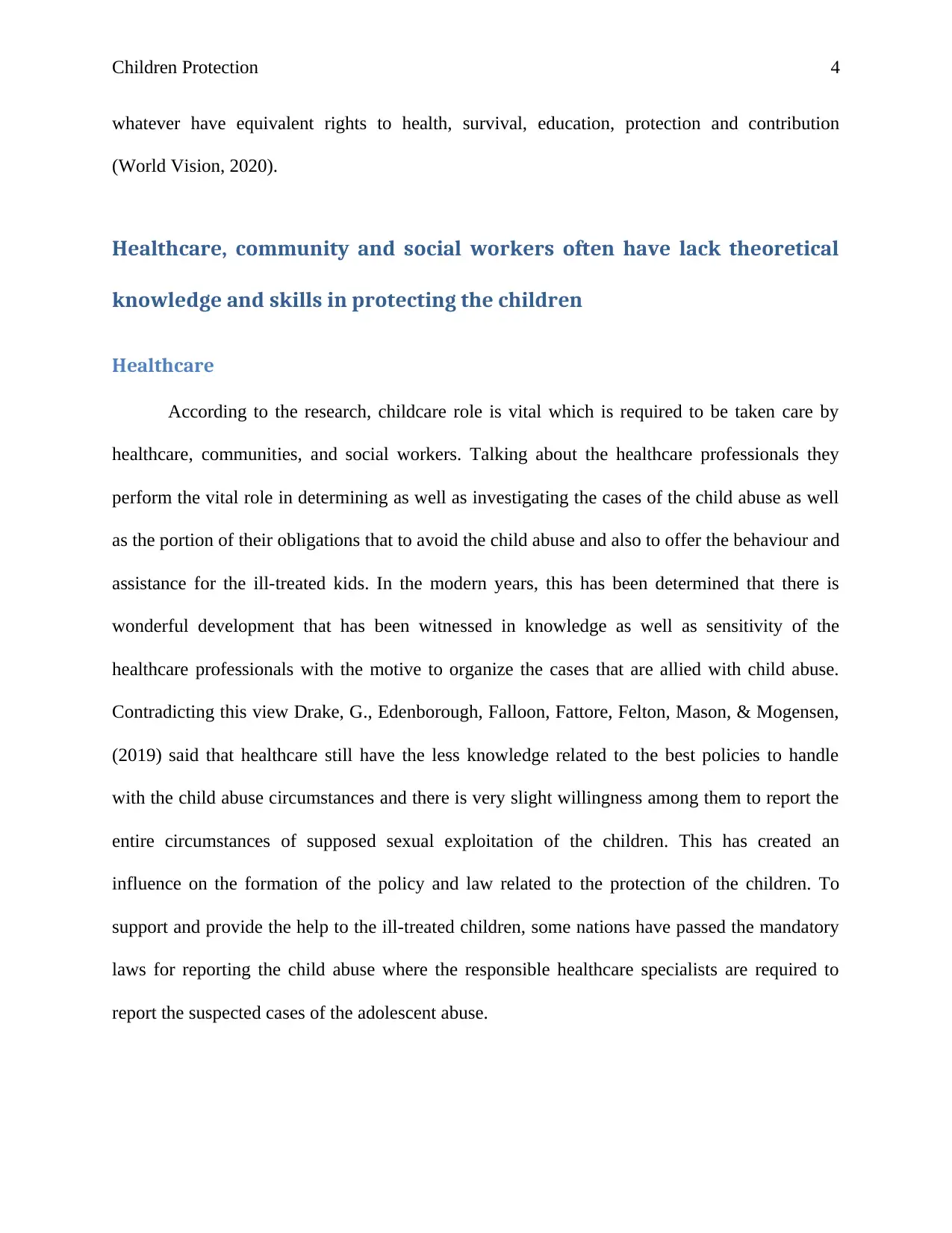
Children Protection 4
whatever have equivalent rights to health, survival, education, protection and contribution
(World Vision, 2020).
Healthcare, community and social workers often have lack theoretical
knowledge and skills in protecting the children
Healthcare
According to the research, childcare role is vital which is required to be taken care by
healthcare, communities, and social workers. Talking about the healthcare professionals they
perform the vital role in determining as well as investigating the cases of the child abuse as well
as the portion of their obligations that to avoid the child abuse and also to offer the behaviour and
assistance for the ill-treated kids. In the modern years, this has been determined that there is
wonderful development that has been witnessed in knowledge as well as sensitivity of the
healthcare professionals with the motive to organize the cases that are allied with child abuse.
Contradicting this view Drake, G., Edenborough, Falloon, Fattore, Felton, Mason, & Mogensen,
(2019) said that healthcare still have the less knowledge related to the best policies to handle
with the child abuse circumstances and there is very slight willingness among them to report the
entire circumstances of supposed sexual exploitation of the children. This has created an
influence on the formation of the policy and law related to the protection of the children. To
support and provide the help to the ill-treated children, some nations have passed the mandatory
laws for reporting the child abuse where the responsible healthcare specialists are required to
report the suspected cases of the adolescent abuse.
whatever have equivalent rights to health, survival, education, protection and contribution
(World Vision, 2020).
Healthcare, community and social workers often have lack theoretical
knowledge and skills in protecting the children
Healthcare
According to the research, childcare role is vital which is required to be taken care by
healthcare, communities, and social workers. Talking about the healthcare professionals they
perform the vital role in determining as well as investigating the cases of the child abuse as well
as the portion of their obligations that to avoid the child abuse and also to offer the behaviour and
assistance for the ill-treated kids. In the modern years, this has been determined that there is
wonderful development that has been witnessed in knowledge as well as sensitivity of the
healthcare professionals with the motive to organize the cases that are allied with child abuse.
Contradicting this view Drake, G., Edenborough, Falloon, Fattore, Felton, Mason, & Mogensen,
(2019) said that healthcare still have the less knowledge related to the best policies to handle
with the child abuse circumstances and there is very slight willingness among them to report the
entire circumstances of supposed sexual exploitation of the children. This has created an
influence on the formation of the policy and law related to the protection of the children. To
support and provide the help to the ill-treated children, some nations have passed the mandatory
laws for reporting the child abuse where the responsible healthcare specialists are required to
report the suspected cases of the adolescent abuse.
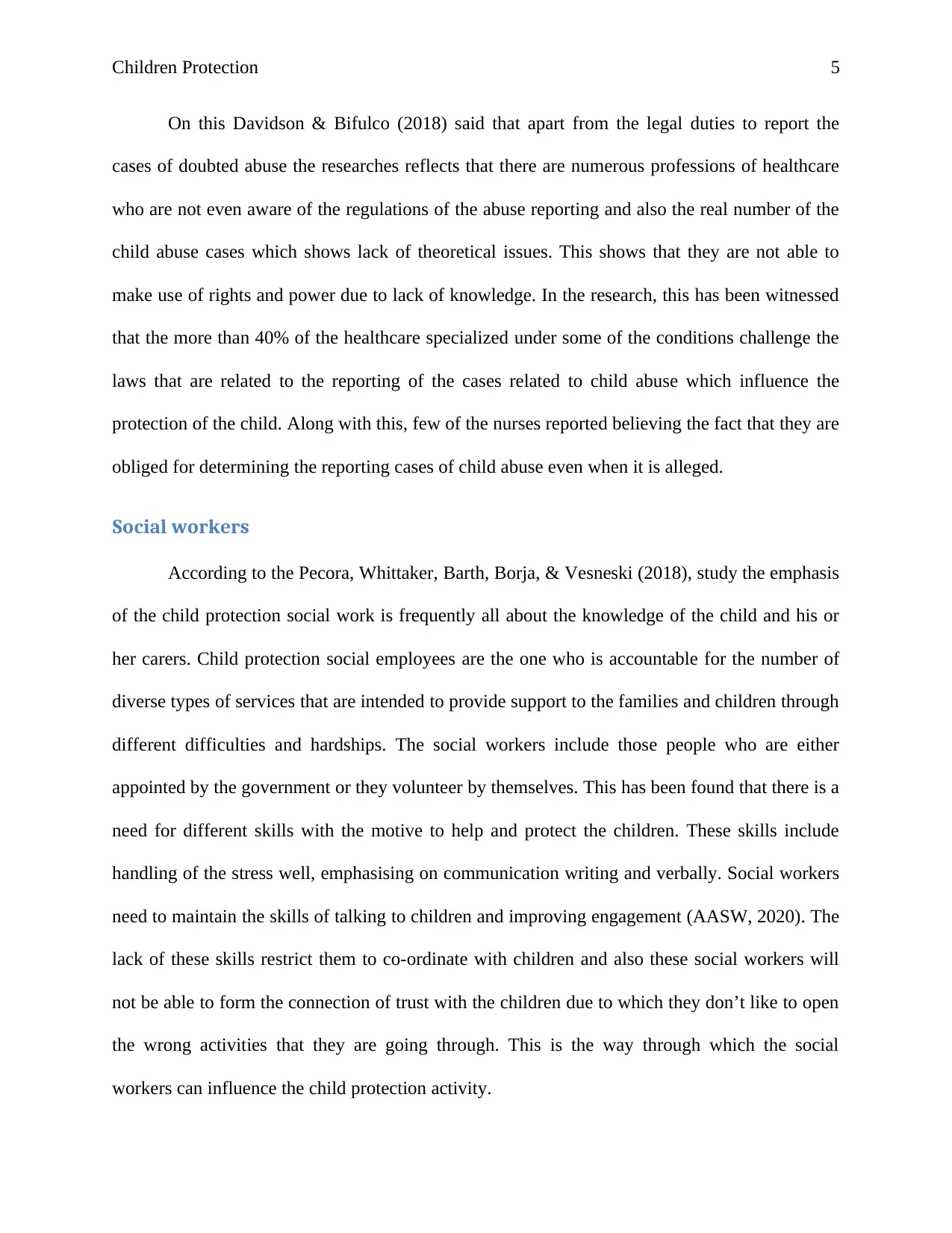
Children Protection 5
On this Davidson & Bifulco (2018) said that apart from the legal duties to report the
cases of doubted abuse the researches reflects that there are numerous professions of healthcare
who are not even aware of the regulations of the abuse reporting and also the real number of the
child abuse cases which shows lack of theoretical issues. This shows that they are not able to
make use of rights and power due to lack of knowledge. In the research, this has been witnessed
that the more than 40% of the healthcare specialized under some of the conditions challenge the
laws that are related to the reporting of the cases related to child abuse which influence the
protection of the child. Along with this, few of the nurses reported believing the fact that they are
obliged for determining the reporting cases of child abuse even when it is alleged.
Social workers
According to the Pecora, Whittaker, Barth, Borja, & Vesneski (2018), study the emphasis
of the child protection social work is frequently all about the knowledge of the child and his or
her carers. Child protection social employees are the one who is accountable for the number of
diverse types of services that are intended to provide support to the families and children through
different difficulties and hardships. The social workers include those people who are either
appointed by the government or they volunteer by themselves. This has been found that there is a
need for different skills with the motive to help and protect the children. These skills include
handling of the stress well, emphasising on communication writing and verbally. Social workers
need to maintain the skills of talking to children and improving engagement (AASW, 2020). The
lack of these skills restrict them to co-ordinate with children and also these social workers will
not be able to form the connection of trust with the children due to which they don’t like to open
the wrong activities that they are going through. This is the way through which the social
workers can influence the child protection activity.
On this Davidson & Bifulco (2018) said that apart from the legal duties to report the
cases of doubted abuse the researches reflects that there are numerous professions of healthcare
who are not even aware of the regulations of the abuse reporting and also the real number of the
child abuse cases which shows lack of theoretical issues. This shows that they are not able to
make use of rights and power due to lack of knowledge. In the research, this has been witnessed
that the more than 40% of the healthcare specialized under some of the conditions challenge the
laws that are related to the reporting of the cases related to child abuse which influence the
protection of the child. Along with this, few of the nurses reported believing the fact that they are
obliged for determining the reporting cases of child abuse even when it is alleged.
Social workers
According to the Pecora, Whittaker, Barth, Borja, & Vesneski (2018), study the emphasis
of the child protection social work is frequently all about the knowledge of the child and his or
her carers. Child protection social employees are the one who is accountable for the number of
diverse types of services that are intended to provide support to the families and children through
different difficulties and hardships. The social workers include those people who are either
appointed by the government or they volunteer by themselves. This has been found that there is a
need for different skills with the motive to help and protect the children. These skills include
handling of the stress well, emphasising on communication writing and verbally. Social workers
need to maintain the skills of talking to children and improving engagement (AASW, 2020). The
lack of these skills restrict them to co-ordinate with children and also these social workers will
not be able to form the connection of trust with the children due to which they don’t like to open
the wrong activities that they are going through. This is the way through which the social
workers can influence the child protection activity.
⊘ This is a preview!⊘
Do you want full access?
Subscribe today to unlock all pages.

Trusted by 1+ million students worldwide
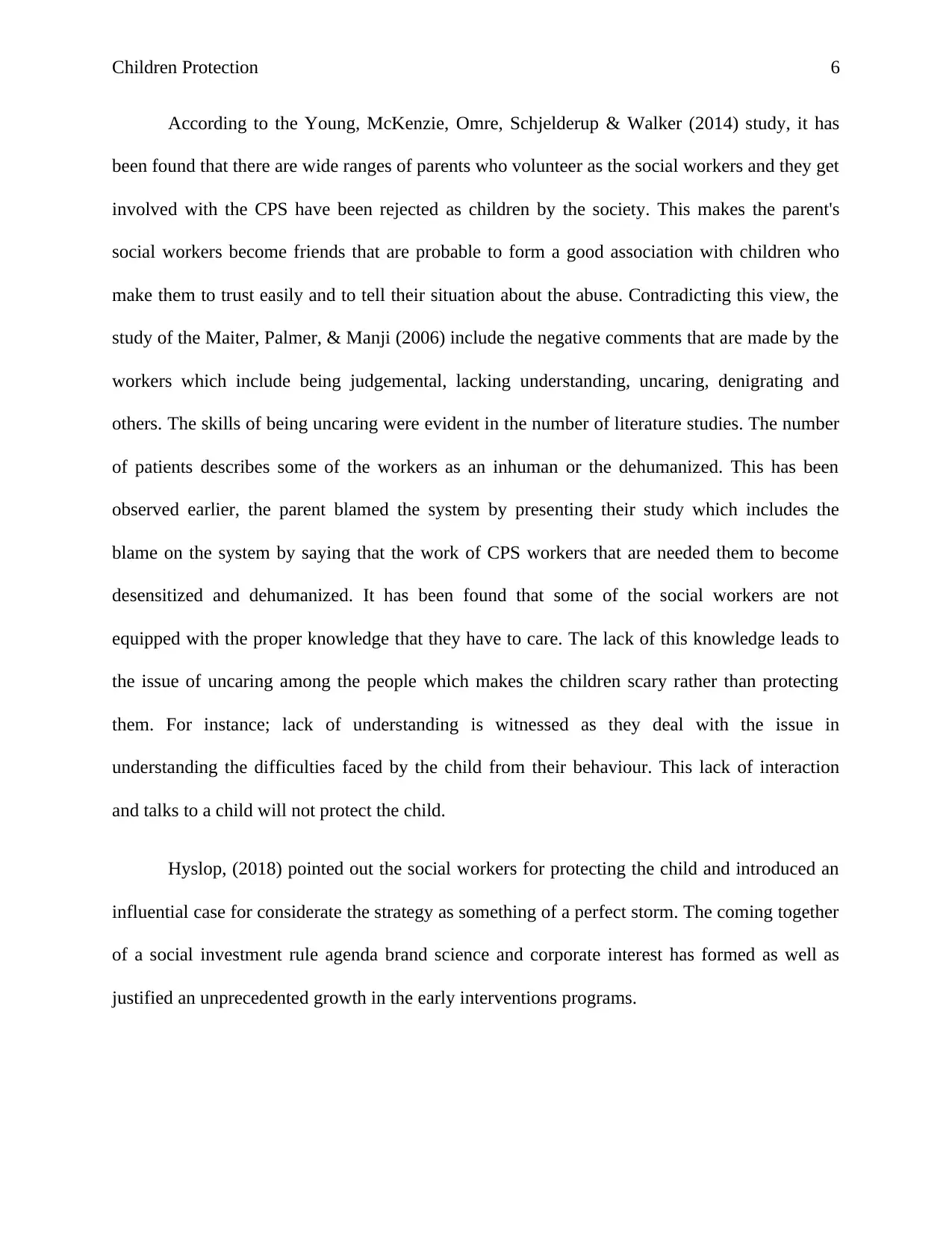
Children Protection 6
According to the Young, McKenzie, Omre, Schjelderup & Walker (2014) study, it has
been found that there are wide ranges of parents who volunteer as the social workers and they get
involved with the CPS have been rejected as children by the society. This makes the parent's
social workers become friends that are probable to form a good association with children who
make them to trust easily and to tell their situation about the abuse. Contradicting this view, the
study of the Maiter, Palmer, & Manji (2006) include the negative comments that are made by the
workers which include being judgemental, lacking understanding, uncaring, denigrating and
others. The skills of being uncaring were evident in the number of literature studies. The number
of patients describes some of the workers as an inhuman or the dehumanized. This has been
observed earlier, the parent blamed the system by presenting their study which includes the
blame on the system by saying that the work of CPS workers that are needed them to become
desensitized and dehumanized. It has been found that some of the social workers are not
equipped with the proper knowledge that they have to care. The lack of this knowledge leads to
the issue of uncaring among the people which makes the children scary rather than protecting
them. For instance; lack of understanding is witnessed as they deal with the issue in
understanding the difficulties faced by the child from their behaviour. This lack of interaction
and talks to a child will not protect the child.
Hyslop, (2018) pointed out the social workers for protecting the child and introduced an
influential case for considerate the strategy as something of a perfect storm. The coming together
of a social investment rule agenda brand science and corporate interest has formed as well as
justified an unprecedented growth in the early interventions programs.
According to the Young, McKenzie, Omre, Schjelderup & Walker (2014) study, it has
been found that there are wide ranges of parents who volunteer as the social workers and they get
involved with the CPS have been rejected as children by the society. This makes the parent's
social workers become friends that are probable to form a good association with children who
make them to trust easily and to tell their situation about the abuse. Contradicting this view, the
study of the Maiter, Palmer, & Manji (2006) include the negative comments that are made by the
workers which include being judgemental, lacking understanding, uncaring, denigrating and
others. The skills of being uncaring were evident in the number of literature studies. The number
of patients describes some of the workers as an inhuman or the dehumanized. This has been
observed earlier, the parent blamed the system by presenting their study which includes the
blame on the system by saying that the work of CPS workers that are needed them to become
desensitized and dehumanized. It has been found that some of the social workers are not
equipped with the proper knowledge that they have to care. The lack of this knowledge leads to
the issue of uncaring among the people which makes the children scary rather than protecting
them. For instance; lack of understanding is witnessed as they deal with the issue in
understanding the difficulties faced by the child from their behaviour. This lack of interaction
and talks to a child will not protect the child.
Hyslop, (2018) pointed out the social workers for protecting the child and introduced an
influential case for considerate the strategy as something of a perfect storm. The coming together
of a social investment rule agenda brand science and corporate interest has formed as well as
justified an unprecedented growth in the early interventions programs.
Paraphrase This Document
Need a fresh take? Get an instant paraphrase of this document with our AI Paraphraser
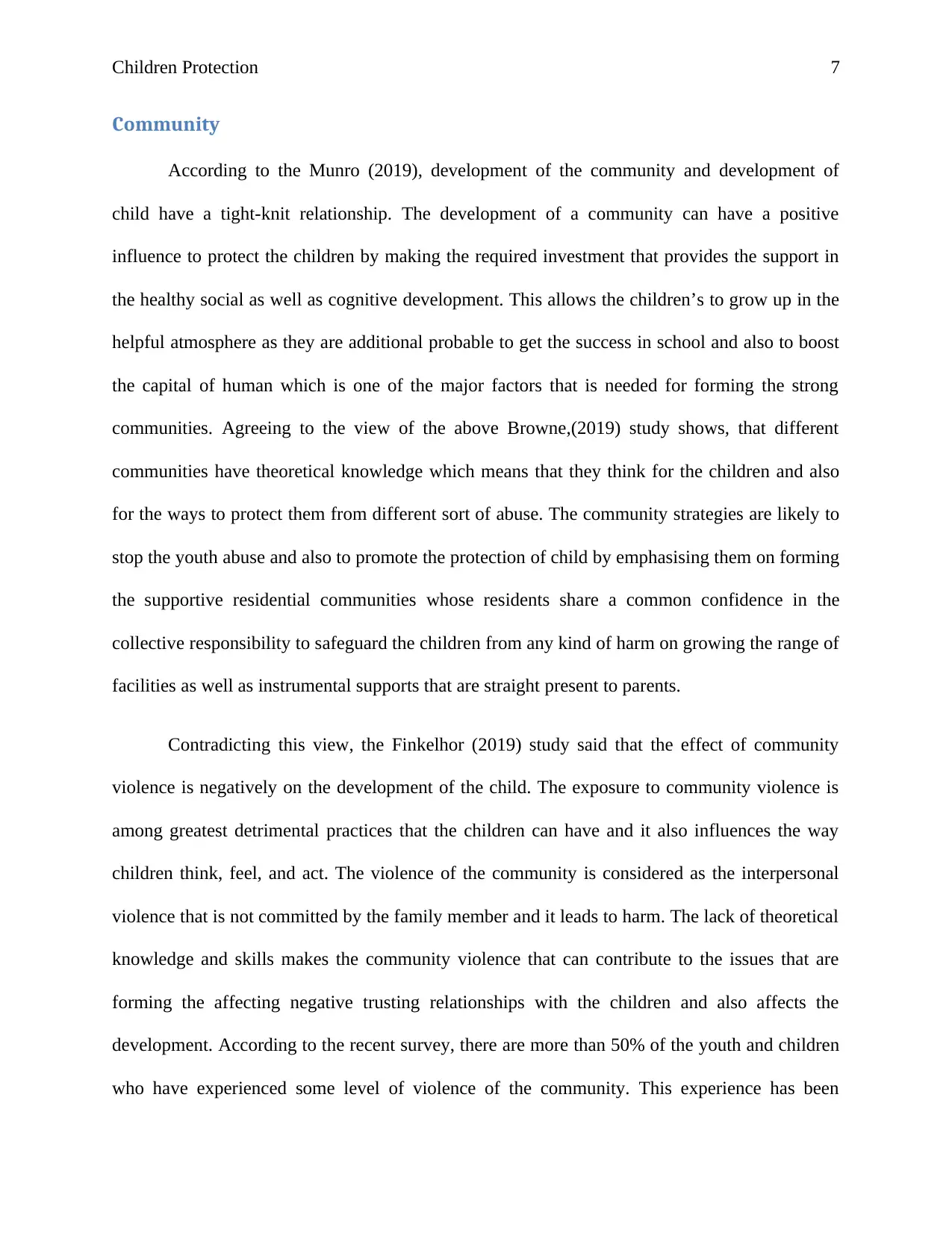
Children Protection 7
Community
According to the Munro (2019), development of the community and development of
child have a tight-knit relationship. The development of a community can have a positive
influence to protect the children by making the required investment that provides the support in
the healthy social as well as cognitive development. This allows the children’s to grow up in the
helpful atmosphere as they are additional probable to get the success in school and also to boost
the capital of human which is one of the major factors that is needed for forming the strong
communities. Agreeing to the view of the above Browne,(2019) study shows, that different
communities have theoretical knowledge which means that they think for the children and also
for the ways to protect them from different sort of abuse. The community strategies are likely to
stop the youth abuse and also to promote the protection of child by emphasising them on forming
the supportive residential communities whose residents share a common confidence in the
collective responsibility to safeguard the children from any kind of harm on growing the range of
facilities as well as instrumental supports that are straight present to parents.
Contradicting this view, the Finkelhor (2019) study said that the effect of community
violence is negatively on the development of the child. The exposure to community violence is
among greatest detrimental practices that the children can have and it also influences the way
children think, feel, and act. The violence of the community is considered as the interpersonal
violence that is not committed by the family member and it leads to harm. The lack of theoretical
knowledge and skills makes the community violence that can contribute to the issues that are
forming the affecting negative trusting relationships with the children and also affects the
development. According to the recent survey, there are more than 50% of the youth and children
who have experienced some level of violence of the community. This experience has been
Community
According to the Munro (2019), development of the community and development of
child have a tight-knit relationship. The development of a community can have a positive
influence to protect the children by making the required investment that provides the support in
the healthy social as well as cognitive development. This allows the children’s to grow up in the
helpful atmosphere as they are additional probable to get the success in school and also to boost
the capital of human which is one of the major factors that is needed for forming the strong
communities. Agreeing to the view of the above Browne,(2019) study shows, that different
communities have theoretical knowledge which means that they think for the children and also
for the ways to protect them from different sort of abuse. The community strategies are likely to
stop the youth abuse and also to promote the protection of child by emphasising them on forming
the supportive residential communities whose residents share a common confidence in the
collective responsibility to safeguard the children from any kind of harm on growing the range of
facilities as well as instrumental supports that are straight present to parents.
Contradicting this view, the Finkelhor (2019) study said that the effect of community
violence is negatively on the development of the child. The exposure to community violence is
among greatest detrimental practices that the children can have and it also influences the way
children think, feel, and act. The violence of the community is considered as the interpersonal
violence that is not committed by the family member and it leads to harm. The lack of theoretical
knowledge and skills makes the community violence that can contribute to the issues that are
forming the affecting negative trusting relationships with the children and also affects the
development. According to the recent survey, there are more than 50% of the youth and children
who have experienced some level of violence of the community. This experience has been
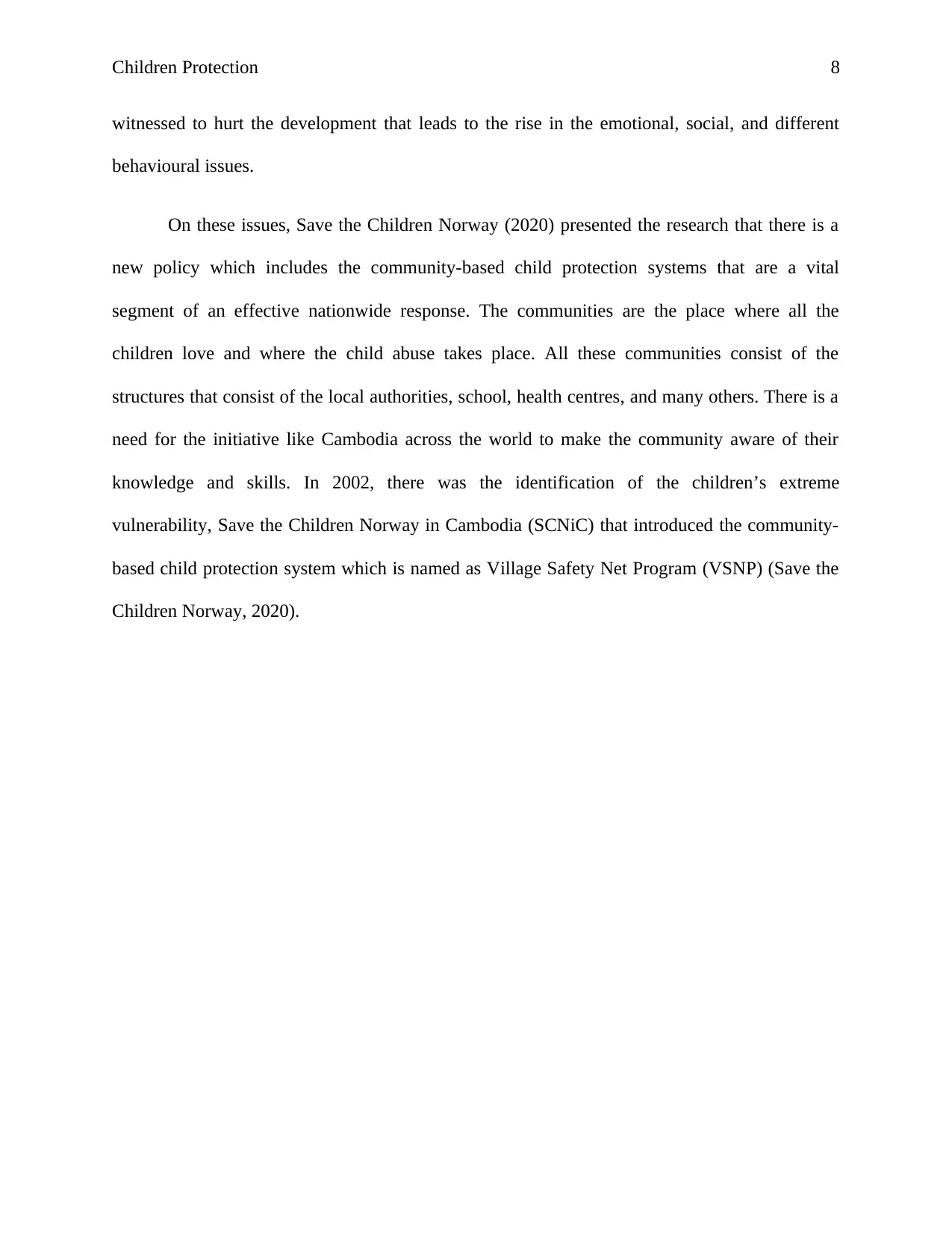
Children Protection 8
witnessed to hurt the development that leads to the rise in the emotional, social, and different
behavioural issues.
On these issues, Save the Children Norway (2020) presented the research that there is a
new policy which includes the community-based child protection systems that are a vital
segment of an effective nationwide response. The communities are the place where all the
children love and where the child abuse takes place. All these communities consist of the
structures that consist of the local authorities, school, health centres, and many others. There is a
need for the initiative like Cambodia across the world to make the community aware of their
knowledge and skills. In 2002, there was the identification of the children’s extreme
vulnerability, Save the Children Norway in Cambodia (SCNiC) that introduced the community-
based child protection system which is named as Village Safety Net Program (VSNP) (Save the
Children Norway, 2020).
witnessed to hurt the development that leads to the rise in the emotional, social, and different
behavioural issues.
On these issues, Save the Children Norway (2020) presented the research that there is a
new policy which includes the community-based child protection systems that are a vital
segment of an effective nationwide response. The communities are the place where all the
children love and where the child abuse takes place. All these communities consist of the
structures that consist of the local authorities, school, health centres, and many others. There is a
need for the initiative like Cambodia across the world to make the community aware of their
knowledge and skills. In 2002, there was the identification of the children’s extreme
vulnerability, Save the Children Norway in Cambodia (SCNiC) that introduced the community-
based child protection system which is named as Village Safety Net Program (VSNP) (Save the
Children Norway, 2020).
⊘ This is a preview!⊘
Do you want full access?
Subscribe today to unlock all pages.

Trusted by 1+ million students worldwide
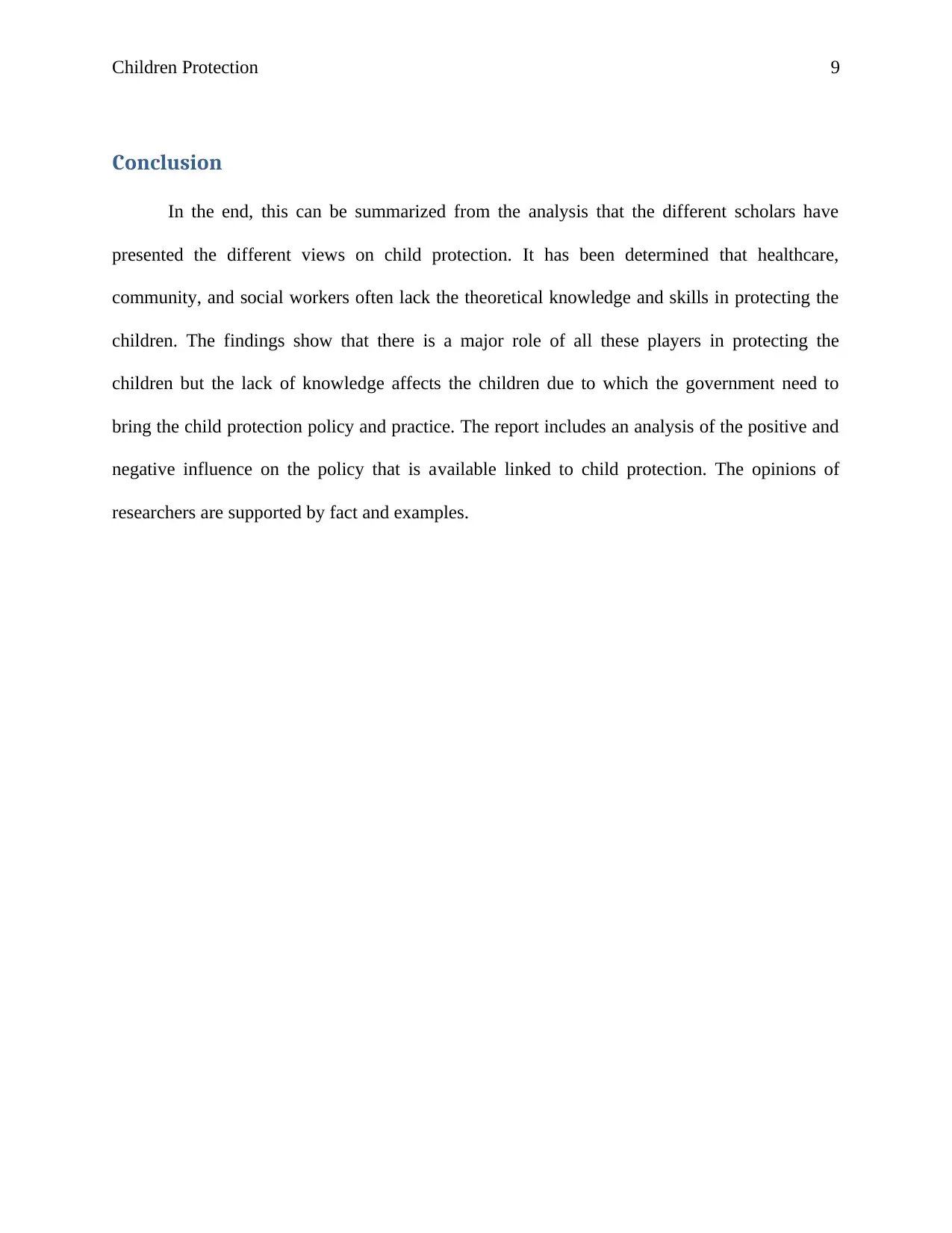
Children Protection 9
Conclusion
In the end, this can be summarized from the analysis that the different scholars have
presented the different views on child protection. It has been determined that healthcare,
community, and social workers often lack the theoretical knowledge and skills in protecting the
children. The findings show that there is a major role of all these players in protecting the
children but the lack of knowledge affects the children due to which the government need to
bring the child protection policy and practice. The report includes an analysis of the positive and
negative influence on the policy that is available linked to child protection. The opinions of
researchers are supported by fact and examples.
Conclusion
In the end, this can be summarized from the analysis that the different scholars have
presented the different views on child protection. It has been determined that healthcare,
community, and social workers often lack the theoretical knowledge and skills in protecting the
children. The findings show that there is a major role of all these players in protecting the
children but the lack of knowledge affects the children due to which the government need to
bring the child protection policy and practice. The report includes an analysis of the positive and
negative influence on the policy that is available linked to child protection. The opinions of
researchers are supported by fact and examples.
Paraphrase This Document
Need a fresh take? Get an instant paraphrase of this document with our AI Paraphraser
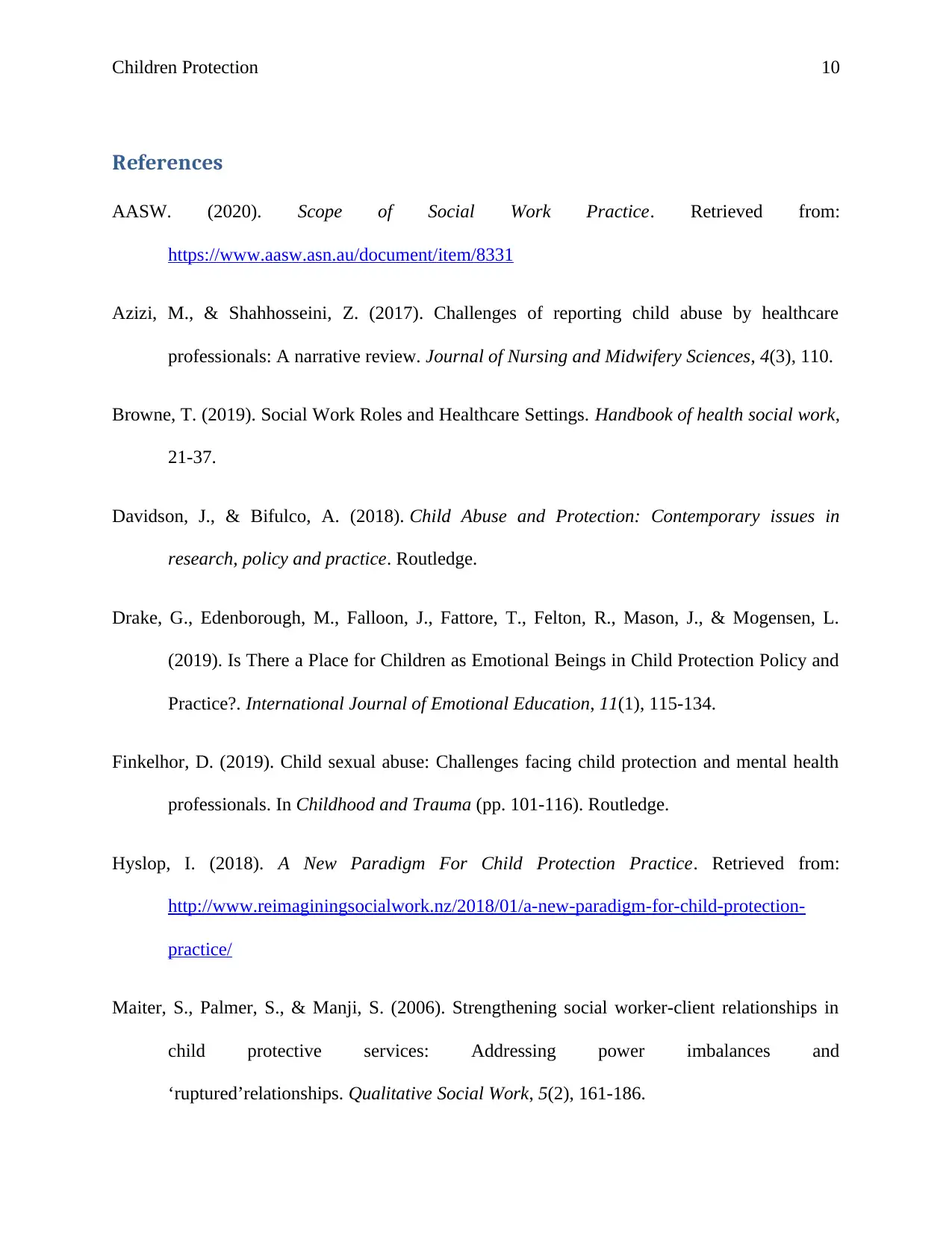
Children Protection 10
References
AASW. (2020). Scope of Social Work Practice. Retrieved from:
https://www.aasw.asn.au/document/item/8331
Azizi, M., & Shahhosseini, Z. (2017). Challenges of reporting child abuse by healthcare
professionals: A narrative review. Journal of Nursing and Midwifery Sciences, 4(3), 110.
Browne, T. (2019). Social Work Roles and Healthcare Settings. Handbook of health social work,
21-37.
Davidson, J., & Bifulco, A. (2018). Child Abuse and Protection: Contemporary issues in
research, policy and practice. Routledge.
Drake, G., Edenborough, M., Falloon, J., Fattore, T., Felton, R., Mason, J., & Mogensen, L.
(2019). Is There a Place for Children as Emotional Beings in Child Protection Policy and
Practice?. International Journal of Emotional Education, 11(1), 115-134.
Finkelhor, D. (2019). Child sexual abuse: Challenges facing child protection and mental health
professionals. In Childhood and Trauma (pp. 101-116). Routledge.
Hyslop, I. (2018). A New Paradigm For Child Protection Practice. Retrieved from:
http://www.reimaginingsocialwork.nz/2018/01/a-new-paradigm-for-child-protection-
practice/
Maiter, S., Palmer, S., & Manji, S. (2006). Strengthening social worker-client relationships in
child protective services: Addressing power imbalances and
‘ruptured’relationships. Qualitative Social Work, 5(2), 161-186.
References
AASW. (2020). Scope of Social Work Practice. Retrieved from:
https://www.aasw.asn.au/document/item/8331
Azizi, M., & Shahhosseini, Z. (2017). Challenges of reporting child abuse by healthcare
professionals: A narrative review. Journal of Nursing and Midwifery Sciences, 4(3), 110.
Browne, T. (2019). Social Work Roles and Healthcare Settings. Handbook of health social work,
21-37.
Davidson, J., & Bifulco, A. (2018). Child Abuse and Protection: Contemporary issues in
research, policy and practice. Routledge.
Drake, G., Edenborough, M., Falloon, J., Fattore, T., Felton, R., Mason, J., & Mogensen, L.
(2019). Is There a Place for Children as Emotional Beings in Child Protection Policy and
Practice?. International Journal of Emotional Education, 11(1), 115-134.
Finkelhor, D. (2019). Child sexual abuse: Challenges facing child protection and mental health
professionals. In Childhood and Trauma (pp. 101-116). Routledge.
Hyslop, I. (2018). A New Paradigm For Child Protection Practice. Retrieved from:
http://www.reimaginingsocialwork.nz/2018/01/a-new-paradigm-for-child-protection-
practice/
Maiter, S., Palmer, S., & Manji, S. (2006). Strengthening social worker-client relationships in
child protective services: Addressing power imbalances and
‘ruptured’relationships. Qualitative Social Work, 5(2), 161-186.
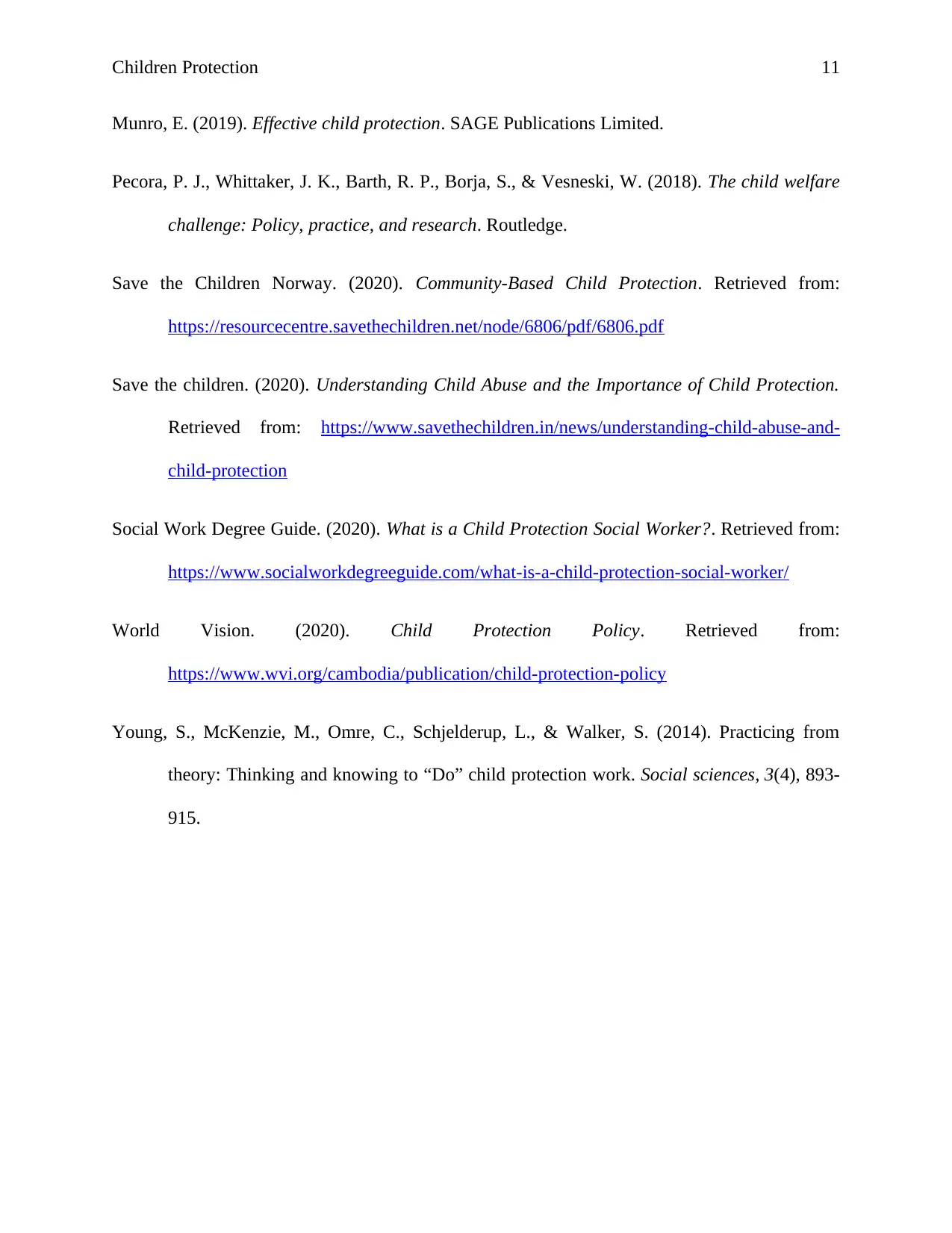
Children Protection 11
Munro, E. (2019). Effective child protection. SAGE Publications Limited.
Pecora, P. J., Whittaker, J. K., Barth, R. P., Borja, S., & Vesneski, W. (2018). The child welfare
challenge: Policy, practice, and research. Routledge.
Save the Children Norway. (2020). Community-Based Child Protection. Retrieved from:
https://resourcecentre.savethechildren.net/node/6806/pdf/6806.pdf
Save the children. (2020). Understanding Child Abuse and the Importance of Child Protection.
Retrieved from: https://www.savethechildren.in/news/understanding-child-abuse-and-
child-protection
Social Work Degree Guide. (2020). What is a Child Protection Social Worker?. Retrieved from:
https://www.socialworkdegreeguide.com/what-is-a-child-protection-social-worker/
World Vision. (2020). Child Protection Policy. Retrieved from:
https://www.wvi.org/cambodia/publication/child-protection-policy
Young, S., McKenzie, M., Omre, C., Schjelderup, L., & Walker, S. (2014). Practicing from
theory: Thinking and knowing to “Do” child protection work. Social sciences, 3(4), 893-
915.
Munro, E. (2019). Effective child protection. SAGE Publications Limited.
Pecora, P. J., Whittaker, J. K., Barth, R. P., Borja, S., & Vesneski, W. (2018). The child welfare
challenge: Policy, practice, and research. Routledge.
Save the Children Norway. (2020). Community-Based Child Protection. Retrieved from:
https://resourcecentre.savethechildren.net/node/6806/pdf/6806.pdf
Save the children. (2020). Understanding Child Abuse and the Importance of Child Protection.
Retrieved from: https://www.savethechildren.in/news/understanding-child-abuse-and-
child-protection
Social Work Degree Guide. (2020). What is a Child Protection Social Worker?. Retrieved from:
https://www.socialworkdegreeguide.com/what-is-a-child-protection-social-worker/
World Vision. (2020). Child Protection Policy. Retrieved from:
https://www.wvi.org/cambodia/publication/child-protection-policy
Young, S., McKenzie, M., Omre, C., Schjelderup, L., & Walker, S. (2014). Practicing from
theory: Thinking and knowing to “Do” child protection work. Social sciences, 3(4), 893-
915.
⊘ This is a preview!⊘
Do you want full access?
Subscribe today to unlock all pages.

Trusted by 1+ million students worldwide
1 out of 12
Related Documents
Your All-in-One AI-Powered Toolkit for Academic Success.
+13062052269
info@desklib.com
Available 24*7 on WhatsApp / Email
![[object Object]](/_next/static/media/star-bottom.7253800d.svg)
Unlock your academic potential
Copyright © 2020–2025 A2Z Services. All Rights Reserved. Developed and managed by ZUCOL.



